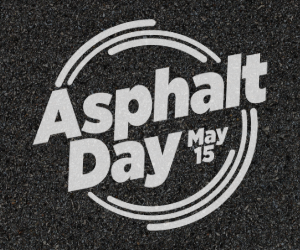How can we make our asphalt mixes better?
More specifically, what steps can be taken to improve durability, rut-resistance and crack resistance.
We look at three basic steps:
• Adjust the gradation to ensure adequate VMA (voids in mineral aggregate) and thus sufficient binder
• Allow for proper air voids in combination with VMA
• Understand and control the impact of RAP (reclaimed asphalt pavement) and RAS (reclaimed asphalt shingles) in our mix
Let’s look at VMA, which stands for “Voids in Mineral Aggregate.” VMA is the space between the rocks that can be filled with asphalt. The space filled with asphalt is known as VFA (Voids Filled with Asphalt). The remaining space is air voids.
VMA is critical to a mixture’s durability and crack resistance. When VMA is lowered, you lower the asphalt binder content for a given air void level (typically 4.0 percent for Superpave mix design). And when you lower the asphalt content, the mix becomes more economical but also less durable.
To understand proper VMA, we can go back to the 1990s during the development of Superpave. A critical component of Superpave mix design is the minimum VMA criteria for each different size mix. A 9.5 mm mix has a minimum VMA of 15.0 percent, a 12.5 mm mix is 14.0 percent, and a 19 mm mix is 13.0 percent. Smaller stone mixes have more aggregate surface area to coat, thus requiring more VMA and more asphalt.
VMA drives binder content
The lower the VMA, the lower the asphalt content for a given air void level. Mix designers and contractors who are focused on making their mix less costly will often design their gradation to be as close to the minimum VMA requirement as possible. This allows for the lowest design (optimum) asphalt content while still meeting specifications. That mix may be slightly more economical to produce, but durability can suffer. This is why Superpave and most specifications require a minimum VMA, which should always be met.
VMA collapse during production
VMA in a mix will typically drop when going from mix design to production. This is because there is more aggregate breakdown and dust generated in an asphalt plant relative to the mix design process. To help capture this important concept, think of the aggregate tumbling aggressively in a plant drum versus being stirred by a whip in a mixing bowl. The VMA drop is typically from 0.2 percent to 0.5 percent, depending on aggregate hardness. To avoid problems, mix designers should either design higher than the minimum, or add a modest amount of dust during the mix design to plan for the breakdown.
Recognizing this phenomenon of VMA collapse, some states currently allow the minimum VMA criteria to drop during field production. Specifiers need to realize that allowing this will typically reduce the asphalt content from mix design to field production. For example, if an agency allows lowering the VMA by 0.5 percent, that will typically result in the asphalt content dropping 0.1 to 0.2 percent. In addition, some specifications allow lowering the optimum asphalt content from mix design by 0.3 to 0.5 percent for field adjustments.
Lowering asphalt content in the field often means our pavements are under-asphalted or dry. This can lead to early raveling and cracking since the binder serves as the glue. Lower asphalt content can also mean the mix is harder to compact.
Air voids
Superpave has us designing mixes at 4.0 percent air voids. Some states, in an attempt to get more binder in their mix, are designing at slightly less than 4.0 percent air voids, such as 3.5 percent. Other states allow for a range on design air voids, such as 3.8 to 4.2 percent. Just as the mix designer tries to remain cost competitive by designing on the low end of VMA, they also will design at the high end of voids. Again, this will lower durability by making our mixes drier.
RAP/RAS
The third item we need to look at is the use of RAP (reclaimed asphalt pavement) and RAS (reclaimed asphalt shingles) in the mix design. While the use of RAS is somewhat new, RAP has been around for many years but usage and design practices vary greatly.
RAP has many benefits. It reduces the cost of asphalt mix per mile, adds strength to the pavement because of the angularity of the RAP aggregate and reduces virgin material requirements. However, I personally do not believe that we fully understand the impact of either RAP or RAS on long-term pavement performance properties, especially cracking.
While we know that state departments of transportation (DOTs) and local road and street agencies recommend a wide range of RAP and RAS guidelines, we also know that for every increase in RAP or RAS percentage, we lower the percentage of new asphalt binder. Also, increased use of RAP or RAS will result in a more brittle mix if the Performance Grade (PG) is not lowered.
Many assumptions are made in the mix design process when utilizing RAP. One of them is the assumption that 100 percent of the RAP binder releases and mixes with the new (virgin) binder. If the assumption is wrong and not all the RAP binder releases, then we are low on asphalt.
With RAS, agencies typically assume that 70 to 80 percent of the RAS binder mixes with the virgin materials. However, it is my opinion that the percentage is likely less than that because most RAS is barely fluid at 400 degrees Fahrenheit. Temperature at the average hot mix plant will usually not exceed 325-340 degrees, and even less with warm mix additives. Because the RAS is not fluid, it is very likely the amount of RAS binder activated is much less than assumed in the mix design.
The big picture
If we look at the big picture, we are losing asphalt from lower VMAs, higher air voids design ranges and the amount of RAP and RAS used in the mix. It is not unreasonable to conclude that these combined factors could reduce the percentage of asphalt binder in an average asphalt mixture by 0.2 to 0.6 percent by weight of the total mix.
However, by maintaining minimum VMA, the proper design percentage of air voids, and more fully planning for the impact of RAP and RAS in the mix, we can improve our asphalt mix designs.
For further information about RAP and RAS, see chapter 11 in the Asphalt Institute’s “MS-2, Asphalt Mix Design Methods, 7th Edition” available at asphaltinstitute.org.
Blankenship is the Senior Research Engineer at the Asphalt Institute.















